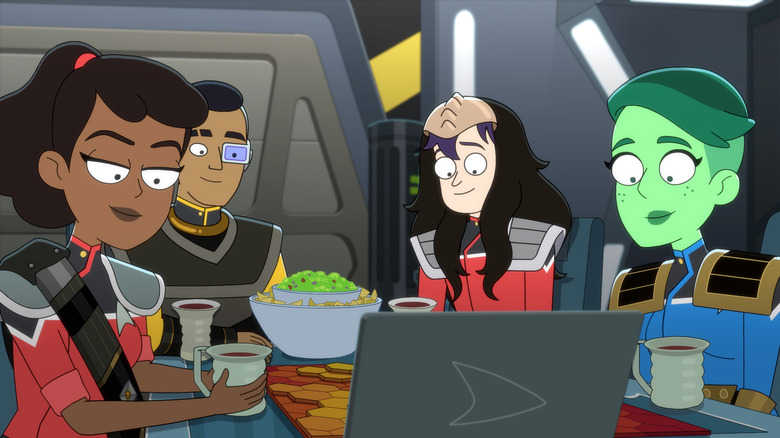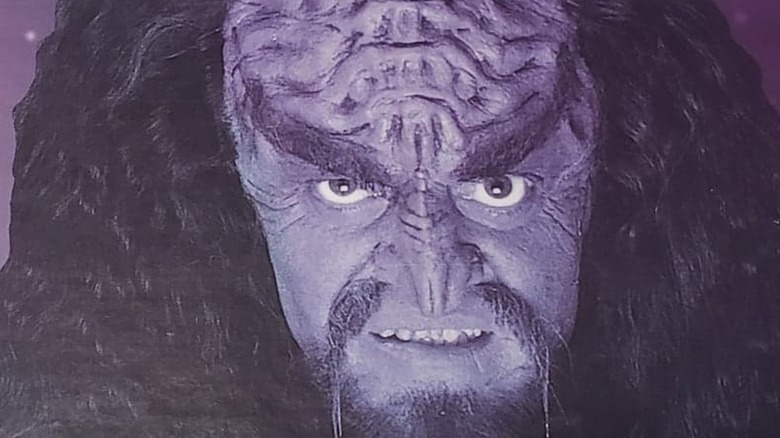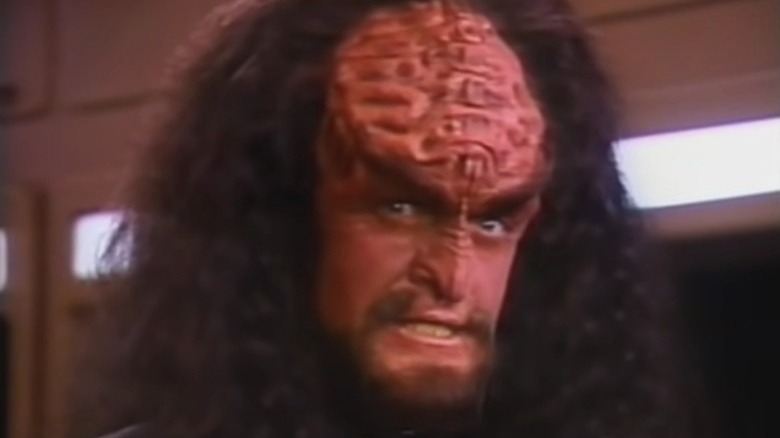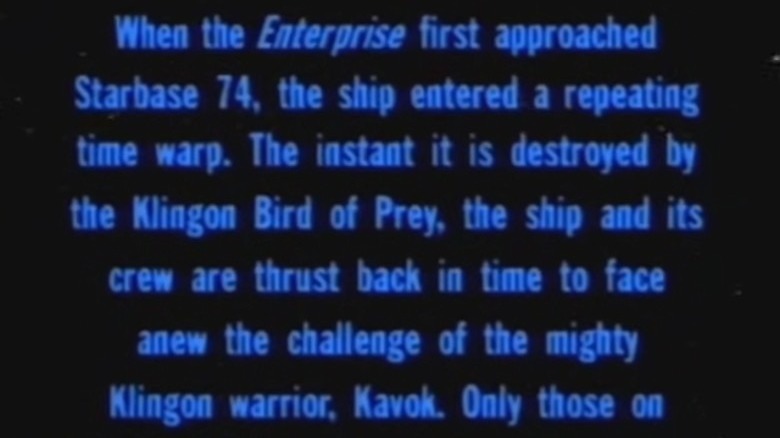Star Trek: Lower Decks Season 3 Revives One Of The Most Infamous Pieces Of Star Trek Merch Ever
In the opening scene of "The Least Dangerous Game" — the second episode of the third season of "Star Trek: Lower Decks" — the show's four main characters, in a rare moment of downtime, gather around a table to play a Klingon-based boardgame called "Bat'leths & bIHnuchs." The players are all dressed in Klingon clothing, and they drink from tapered ridged mugs that Klingons are typically seen using throughout "Star Trek." The game board is a hexagonal grid, and bears the red/blood orange/goldenrod color scheme of "The Settlers of Catan." The players roll a 20-sided die.
The central feature of "Bat'leths & bIHnuchs," however, is a small video screen arranged behind the board wherein a pre-recorded game master offers an introduction, dictates the actions of the players, and reacts angrily when they make a bad decision. The game master is none other than Martok (J.G. Hertzler), a recurring Klingon character from "Star Trek: Deep Space Nine." Evidently, in the timeline of "Lower Decks," Martok was a big enough celebrity to headline his own board game. Or at least a knock-off boardgame; Boimler (Jack Quaid) mentions that he acquired a Ferengi bootleg.
While the title of "Bat'leths & bIHnuchs" is a clear allusion to "Dungeons & Dragons," and the look of the game is modeled on "Catan," the concept of a pre-recorded Klingon game master dictating the events of a board game from a screen set up near the play area is clearly a direct reference to a notorious real-life board game put out by Milton Bradley in 1993. Deep-cut Trekkies know well the pleasures of playing "Star Trek: The Next Generation Interactive VCR Board Game – A Klingon Challenge."
Star Trek: The Next Generation Interactive VCR Board Game – A Klingon Challenge
The interactive VCR board game was a brief, never-really-caught-on trend from the late '80s and early '90s when VCRs had infiltrated most consumers' homes. The idea was that, like in "Lower Decks," players would set up a board game within visual range of their television, and they would be able to play a board game while watching a cassette simultaneously. The trend included "VCR Hockey Night in Canada," "Wayne's World VCR Board Game," the "Nightmare" series (turn the volume up and the lights down!), and a narrative-based redux of "Candy Land." The games were plenty fun, although the novelty of an "interactive screen" is now unbearably quaint. Thanks to the magic of YouTube (you can watch the entirety of "Klingon Challenge" right here), these games can still be played by those with access to eBay, but who do not own a working VCR.
Into the middle of the trend came "Star Trek: The Next Generation Interactive VCR Board Game – A Klingon Challenge," another piece of "Trek" tie-in merchandise that came when a massive volume of franchise-related tchotchkes was flooding the market. The premise of the game was that the Enterprise-D has docked at a local Starbase for repairs, and all of the Starfleet officers have left the ship. There are no extended appearances from any central members of the NextGen cast. The only people left on the ship are the players, each of them ensigns.
The game came with a sheet of stickers, allowing players to festoon their shirts with communicators and rank pips, should the urge strike. If you win, you can stick a medal on your shirt. Anyone who finds "A Klingon Challenge" on eBay will likely find the sticker sheet to be fully in tact; the communication badges were not a popular feature.
Experience bIj
Meanwhile, on the TV, players see the Klingon warrior Kavok (Robert O'Reilly) beaming onto the docked Enterprise (off camera, as to avoid spending money on the transporter effect). He hijacks the ship and flies it out into space. He knows the players are on board the Enterprise trying to foil him, and he will appear on the TV screen occasionally to threaten them. Meanwhile, the players must move their meeples around a gaming field made to resemble the Enterprise, gathering tools and objects and activating certain systems in order to eventually break onto the bridge and wrest control back from Kavok.
Occasionally, Kavok would appear on the screen to trap players in a force field (a small plastic tube could be slipped over the meeples), or dictate that they "experience bIj," which is equal to drawing a "Chance" card. "BIj," incidentally, is the Klingon word for punishment. Kavok also barked at the players to respond to his interruptions, and you had to give him a "yes, captain!" on command. At the head of the game, players are given a 60-minute countdown clock on the TV screen, a clock that is accelerated from time to time. If the players capture Kavok, they must stop the cassette. If the players fail before time runs out, a handy caption appears on the screen explaining that the Enterprise hit a time warp, and the best way to experience it was to push rewind on your VCR and spin the tape back. Time to play again!
Kavok was played by Robert O'Reilly, who was a bit of an odd choice for a board game-related cameo, as O'Reilly was already known to Trekkies as the Klingon character Gowron.
How is it?
Some of the worst board games in history have been movie and TV show tie-ins, so board game enthusiasts tend to approach some of them — especially older ones — with a degree of skepticism. In recent years, many excellent board games have been spun out of established franchises, so that stigma is mostly gone, but one might still snicker at the idea of a "Star Trek" interactive VCR board game.
Having played the game, I can say that it functions perfectly well. For a game that employed a VCR, the gameplay wasn't terribly complicated, almost by necessity; a 60-minute videocassette introduced a ticking clock element, and players had to play quickly. It made good use of the Trek skin, and Robert O'Reilly — acting on the familiar Enterprise set — gave players a recognizable face. As such, the game had a vital veneer of franchise-approved authenticity. Had Kavok been played by a new actor, many Trekkies would have dismissed the game as something unauthorized. A Ferengi bootleg, if you will.
The game will not be much of a Klingon challenge to those who prefer longer, more heady strategy games; this is something you can play with your eight-year-old (the box recommends ages 8 and up). If it's difficult, complex, long-running, cerebral games you prefer, might I recommend the 2011 "Star Trek: The Deck Building Game – The Next Generation." That one will most assuredly kick your head in.



